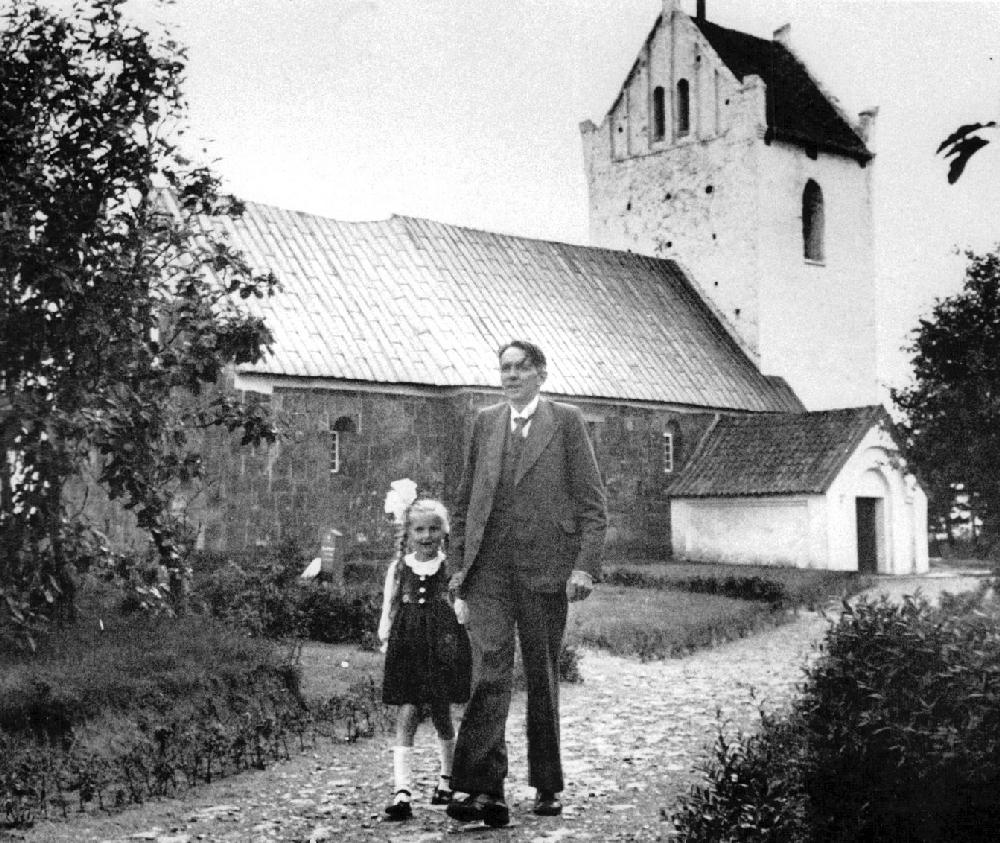
NAZI Occupied Denmark: Resistance

Figure 1.--The Resistance in Demark was similar to that in the Netherlands. Both were small, heavily developed countries bordering in he Reich. There were no forests or mountains to hide. There was no possibility of an armed resistance. The Resistance had to restrict itself to intelligence gathering, saotage, and protecting inviduals targeted by the NAZIs and organizing passive resistance. The one difference between the Danes and the Dutch was geography. The Dutch were hemmed in by the North Sea. The Danes had two coasts, one was also the North Sea, but the eastern coast faved the Baltic and within a few miles was the safe haven. This allowed people to escpe. And the Danish Resistnce manged to spirt not only prominent figures like nuclear phyicist Neils Bohr, but almost their entire Jewish community to safety in Sweden. One of the heros of the Danish Resistance seen here in front of his church with his daughter was Lutheran Priest Kaj Munk. He opposed the policy of collaboration with the NAZIs and from the pulpit preachednon-coopertion. The Gestapo kidnapped and murdered him (January 4, 1944). The Germans handled the murder differently than in the East. Because of his popularity, the Germans tried to blame it on the Resistance.
|
|
One of the most effective Danish acts of resistance came from the Danish military. The Danish Army was demobilized, but not totally eliminated. And Danish military officials had access to sensitive German military information which they passed to the Allies thriugh Stockholm where there was a military attache in the Danish Embassy. With the Germans firmly in control of the country and prepared to brutally apply force, the only real options open to the Danes was passive resistance. This would not work in many countries because the NAZIs were prepraring genocide, not only against the Jews, but also the Slavs. The Danes were different. They were a Nordic people, infact more Nordic than the Germans. Thus race hatred and genocide was not an element of NAZI occupation policy, except for the Danish Jews. The Danish resistance movement began to form in 1941. It was realtively quiet until Danish attitudes toward the NAZIs began to change (1943). The Danish Government that ruled until 1943 essentially played a game of saying one thing to the German occupation forces and then delayed actions for as long as they could. The NAZI authorities became increasingly frustrated. There are many accounts of ordinary people working as slowly as possible and if they could recalibrate a machine to make ruin parts they did. It is difficult to tell just how much of this really occurred. Of course after liberation, everyone made such claims. Actually doing such things during the NAZI occupation was very dangerous. Denmark was very valuable for the NAZIS, producing amunition, war material, and agricultural products. This worked well for the Grmns because they were not as brutal in Denmark as they were in other countries. Race was a factor here, but what Hitler did not understand was that brutality actually impaired the ability to exploit the occupied areas of the NAZI Gro▀raum.
It is one reason why economic activity in NAZI occupied Europe decline precipitously and impaired the NAZI avility to use the captive ntions to support the war effort.
The Resiatance targeted the German military and businesses working for the NAZIs with acts of sabotage actions. There was also growing labor unrest. Massive strikes were staged in many Danish cities (1943). The Danish Government resigned and the NAZIs took over the government. Among other actions they imposed a curfew. Workers left work early on the pretext that they had to tend their gardens because the curfew provented them in the evening. In reality some went out to demonstrate, but this was dangerous. Teenagers and older students did not like passive resistance so they were the ones who carried out many of the sabotage actions. The NAZIs as in other occupied countries targeted the Danish Jews for deportation, maning of course death. Saving the Danish Jews was the finest achievemebt of the resistance, Danes formed the Danish Freedom Council (DFC) (September 1943). By that time it was increaingly clear that the NAZIs were losing the War. They were, however, firmly in control of Denmark. The DFC was the coordinating organization for the Resistance. Some of the major actions were clandestine newspapers, intelligence gathering for the Allies, and sabotage designed to disrupt war production. The DFC worked with Danish political figures. One of the heros of the Danish Resistance seen here in front of his church with his daughter was Lutheran Priest Kaj Munk. He opposed the policy of collaboration with the NAZIs and from the pulpit preachednon-coopertion. The Gestapo kidnapped and murdered him (January 4, 1944). The Germans handled the murder differently than in the East. Because of his popularity, the Germans tried to blame it on the Resistance.
Sources
CIH -- WW II

Navigate the Boys' Historical Clothing Web Site:
[Return to Main World War II Danish page]
[Return to Main World War II country page ]
[Return to Main World War II resistance page]
[About Us]
[Aftermath]
[Biographies]
[Campaigns]
[Children]
[Countries]
[Deciding factors]
[Diplomacy]
[Geo-political crisis]
[Economics]
[Home front]
[Intelligence]
[POWs]
[Resistance]
[Race]
[Refugees]
[Technology]
[Totalitarian powers]
[Bibliographies]
[Contributions]
[FAQs]
[Images]
[Links]
[Registration]
[Tools]
[Return to Main World War II page]
[Return to Main war essay page]
[Return to CIH Home page]
Created: 12:36 AM 1/3/2018
Last updated: 12:36 AM 1/3/2018



